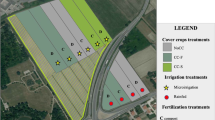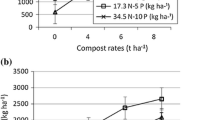Abstract
Organic agriculture can contribute to maintain the long-term sustainability of the agroecosystems, preserve and improve soil quality and guarantee good quality food products. The objective of this study was to investigate the effects of different organic fertilizers and a biostimulant on crop performance and soil properties. The research was performed in an experimental farm in Southern Italy and covered a 2-year rotation of lentil and durum wheat for a period of 4 years. An organic commercial fertilizer and a compost, obtained from municipal wastes, with and without a commercial biostimulant, were compared in a randomized complete block design. The results showed that compost, as the only nutrient source, did not significantly decrease lentil and wheat grain yields, even though, in 2011 and 2012, wheat grain quality was better with the organic commercial fertilizer. Probably, the mineralization rate of compost, depending also on environmental conditions, and, consequently, the nutrient availability was not enough to meet the needs of wheat crop. Biostimulant significantly increased the straw yield of lentil by 20% and the weight of 1000 seeds of wheat by 4%. At the end of the experiment, the compost, applied at low doses, significantly increased soil TOC content (+ 3.4%) compared to the organic commercial fertilizers. Conversely, the biostimulant seemed to have no effect on the soil properties. Overall, under the local Mediterranean conditions, the compost may be used as an alternative nutrient source, with positive effects for lentil and wheat productivity, economic sustainability and soil fertility.





Similar content being viewed by others
References
Aguilera, E., Guzmán, G., & Alonso, A. (2015). Greenhouse gas emissions from conventional and organic cropping systems in Spain. I. Herbaceous crops. Agronomy for Sustainable Development,35, 713–724.
Albiach, R., Canet, R., Pomares, F., & Ingelmo, F. (2001). Organic matter components and aggregate stability after the application of different amendments to a horticultural soil. Bioresource Technology,76, 125–129.
ANPA Manuali e linee guida (3/2001). Metodi di analisi del compost. http://www.insprambiente.gov.it.
Arduini, I., Masoni, A., Ercoli, L., & Mariotti, M. (2006). Grain yield, and dry matter and nitrogen accumulation and remobilization in durum wheat as affected by variety and seeding rate. European Journal of Agronomy,25, 309–318.
Bedoussac, L., Journet, E. P., Hauggaard-Nielsen, H., Naudin, C., Corre-Hellou, G., Jensen, E. S., et al. (2015). Ecological principles underlying the increase of productivity achieved by cereal-grain legume intercrops in organic farming. A review. Agronomy for Sustainable Development,35, 911–935.
Borghi, B., Giordani, G., Corbellini, M., Vaccino, P., Guermandi, M., & Toderi, G. (1995). Influence of crop rotation, manure and fertilizers on bread making quality of wheat (Triticum aestivum L.). European Journal of Agronomy,4, 37–45.
Borrelli, L., Castelli, F., Ceotto, E., Cabassia, G., & Tomasoni, C. (2014). Maize grain and silage yield and yield stability in a long-term cropping system experiment in Northern Italy. European Journal of Agronomy,55, 12–19.
Bues, A., Preißel, S., Reckling, M., Zander, P., Kuhlman, T., Topp, K., Watson, C.L.K.S.F.L., & Murphy-Bokern, D., (2013). The Environmental Role of Protein Crops in the New Common Agricultural Policy. Brussels, Belgium: European Union. http://www.europarl.europa.eu/RegData/etudes/etudes/join/2013/495856/IPOLAGRI_ET%282013%29495856_EN.pdf. Accessed 11 July 2015.
Chen, S. K., Edwards, C. A., & Subler, S. (2003). The influence of two agricultural biostimulants on nitrogen transformations, microbial activity, and plant growth in soil microcosms. Soil Biology & Biochemistry,35, 9–19.
Chivenge, P., Vanlauwe, B., & Six, J. (2011). Does the combined application of organic and mineral nutrient sources influence maize productivity? A meta-analysis. Plant and Soil,342, 1–30.
Debaeke, P., Aussenac, T., Fabre, J. L., Hilaire, A., Pujol, B., & Thuries, L. (1996). Grain nitrogen content of winter bread wheat (Triticum aestivum L.) as related to crop management and to the previous crop. European Journal of Agronomy,5, 273–286.
Dono, G., Severini, S., De Querquis, A., & Ridolfi, S. (2005). Rapporto di analisi e valutazione complessiva del modello di gestione—Valutazione economica della gestione dell’impianto di compostaggio e rapporto sui costi benefici del modello di gestione proposto—Progetto FertiLife: Fertilizzazione sostenibile di un’area orticola intensiva mediante l’utilizzo di biomasse vegetali di scarto. Life02/ENV/IT/000089. https://www.arsial.it/portalearsial/fertiLIFE/pdf/Rapanvalutazcomplessmodello.pdf.
Eghball, B. (2002). Soil properties as influenced by phosphorus- and nitrogen-based manure and compost applications. Agronomy Journal,94, 128–135.
Erskine, W., & El Ashkar, F. (1993). Rainfall and temperature effects on lentil (Lens culinaris) seed yield in Mediterranean environments. The Journal of Agricultural Science,121, 347–354.
Garcia-Gomez, A., Bernal, M. P., & Roig, M. (2002). Growth of ornamental plants in two composts prepared from agroindustrial wastes. Bioresource Technology,83, 81–87.
García-Martínez, A. M., Tejada, M., Díaz, A., Bautista, J. D., Rodríguez, B., & Parrado, J. (2010). Enzymatic production of an organic soil biostimulant from wheat condensed distiller solubles: Effects on soil biochemistry and biodiversity. Process Biochemistry,45, 1127–1133.
Garrido-Lestache, E., Lopez-Bellido, R. J., & Lopez-Bellido, L. (2004). Effect of N rate, timing and splitting and N type on bread-making quality in hard red spring wheat under rainfed Mediterranean conditions. Field Crops Research,85, 213–236.
Geng, Y., Cao, G., Wang, L., & Wang, S. (2019). Effects of equal chemical fertilizer substitutions with organic manure on yield, dry matter, and nitrogen uptake of spring maize and soil nitrogen distribution. PLoS One,14(7), e0219512. https://doi.org/10.1371/journal.pone.0219512.
Giannakis, G. V., Kourgialas, N. N., Paranychianakis, N. V., Nikolaidis, N. P., & Kalogerakis, N. (2014). Effects of municipal solid waste compost on soil properties and vegetables growth. Compost Science & Utilization,22(3), 116–131.
Hammad, H. M., Khaliq, A., Ahmad, A., Aslam, M., Malik, A. H., & Farhad, W. (2011). Influence of different organic manures on wheat productivity. International Journal of Agriculture and Biology,13, 137–140.
Larney, F. J., & Angers, D. A. (2012). The role of organic amendments in soil reclamation: A review. Canadian Journal of Soil Science,92, 19–38.
Leogrande, R., Lopedota, O., Vitti, C., Ventrella, D., & Montemurro, F. (2014). Effects of irrigation volumes and organic fertilizers on eggplant grown in Mediterranean environment. Acta Agriculturae Scandinavica, Section B—Soil & Plant Science,64(6), 518–528.
Leogrande, R., Vitti, C., Stellacci, A. M., Cocozza, C., & Ventrella, D. (2016). Response of wheat crop during transition to organic system under Mediterranean conditions. International Journal of Plant Production,10(4), 565–578.
Lopez-Bellido, L., Lopez-Bellido, R. J., Castillo, J. E., & Lopez-Bellido, F. J. (2001). Effects of long-term tillage, crop rotation and nitrogen fertilization on bread-making quality of hard red spring wheat. Field Crops Research,72, 197–210.
Lopez-Bellido, L., Fuentes, M., Castillo, J. E., & Lopez-Garrido, F. J. (1998). Effects of tillage, crop rotation and nitrogen fertilization on wheat-grain quality grown under rainfed Mediterranean conditions. Field Crops Research,57, 265–276.
Lotter, D. W., Seidel, R., & Liebhart, W. (2003). The performance of organic and conventional cropping systems in an extreme climate year. American Journal of Alternative Agricultures,18, 146–154.
Moldes, A., Cendon, Y., & Barral, M. T. (2007). Evaluation of municipal solid waste compost as a plant growing media component, by applying mixture design. Bioresource Technology,98(16), 3069–3075.
Nemecek, T., von Richthofen, J.-S., Dubois, G., Casta, P., Charles, R., & Pahl, H. (2008). Environmental impacts of introducing grain legumes into European crop rotations. European Journal of Agronomy,28(3), 380–393.
Page, A. L., Miller, R. H., & Keeny, D. R. (1982). Methods of Soil Analysis, Part II (2nd ed.). Madison: American Society of Agronomy.
Parrado, J., Bautista, J., Romero, E. J., García-Martínez, A. M., Friaza, V., & Tejada, M. (2008). Production of a carob enzymatic extract: Potential use as a biofertilizer. Bioresource Technology,99, 2312–2318.
Pellejero, G., Miglierina, A., Aschkar, G., Turcato, M., & Jiménez-Ballesta, R. (2017). Effects of the onion residue compost as an organic fertilizer in a vegetable culture in the Lower Valley of the Rio Negro. International Journal of Recycling of Organic Waste in Agriculture,6, 159–166.
Poudel, D. D., Horwath, W. R., Lanini, W. T., Temple, S. R., & van Bruggen, A. H. C. (2002). Comparison of soil N availability and leaching potential, crop yields and weeds in organic, low-input and conventional farming systems in northern California. Agriculture, Ecosystems & Environment,90, 125–137.
Preissel, S., Reckling, M., Schläfke, N., & Zander, P. (2015). Magnitude and farm-economic value of grain legume pre-crop benefits in Europe: A review. Field Crops Research,175, 64–79.
Sarker, A., Erskine, W., & Singh, M. (2003). Regression models for lentil seed and straw yields in Near East. Agricultural and Forest Meteorology,116, 61–72.
SAS Institute Inc., (2012). SAS/STAT Software, Release 9.3, Cary, N.C., USA.
Smolik, J. D., Dobbs, T. L., & Rickerl, D. H. (1995). The relative sustainability of alternative, conventional, and reduced-till farming systems. American Journal of Alternative Agriculture,10, 25–35.
Soil Survey Staff. (1992). Keys of Soil Taxonomy. In Technical Monograph 19. 5th Ed.; SMSS. Blacksburg, Virginia.
Soumaré, M., Tack, F. M. G., & Verloo, M. G. (2003). Effects of a municipal solid waste compost and mineral fertilization on plant growth in two tropical agricultural soils of Mali. Bioresource Technology,86, 15–20.
Stellacci, A.M., Castrignanò, A., Troccoli, A., Basso, B., & Buttafuoco, G. (2016). Selecting optimal hyperspectral bands to discriminate nitrogen status in durum wheat: A comparison of statistical approaches. Environmental Monitoring and Assessment 188(3), 199: 1–15.
Tejada, M., Benítez, C., Gómez, I., & Parrado, J. (2011). Use of biostimulants on soil restoration: Effects on soil biochemical properties and microbial community. Applied Soil Ecology,49, 11–17.
UNESCO FAO (1963). Bioclimatic map of the Mediterranean zone. UNESCO, Place de Fontanay, Paris, FAO, Viale di Caracalla, Rome, NS162/III, 22A.
Ventrella, D., Vonella, A.V., Fornaro, F., & Giglio, L. (2016a). Durum wheat yield and protein stability depending on residue management in a long term experiment in Southern Italy. In Proceeding of ESA Congress 14—Growing Landscapes—Cultivating Innovative Agricultural Systems (pp. 17–18) 5–9 September, Session 13, Edinburgh, Scotland.
Ventrella, D., Stellacci, A. M., Castrignanò, A., Charfeddine, M., & Castellini, M. (2016b). Effects of crop residue management on winter durum wheat productivity in a long term experiment in Southern Italy. European Journal of Agronomy,77, 188–198.
Viaud, V., Angers, D. A., & Walter, C. (2010). Toward landscape-scale modeling of soil organic matter dynamics in agroecosystems. Soil Science Society of America Journal,74, 1847–1860.
Vitti, C., Stellacci, A. M., Leogrande, R., Mastrangelo, M., Cazzato, E., & Ventrella, D. (2016). Assessment of organic carbon in soils: A comparison between Springer-Klee wet digestion and the dry combustion methods in Mediterranean soils (Southern Italy). CATENA,137, 113–119.
Wang, D., He, N. P., Wang, Q., Lu, Y. L., Wang, Q. F., Xu, Z. W., et al. (2016). Effects of temperature and moisture on soil organic matter decomposition along elevation gradients on the Changbai Mountains, Northeast China. Pedosphere,26(3), 399–407.
Xin, X. L., Qin, S. W., Zhang, J. B., Zhu, A. N., Yang, W. L., & Zhang, X. F. (2017). Yield, phosphorus use efficiency and balance response to substituting long-term chemical fertilizer use with organic manure in a wheat-maize system. Field Crops Researchs,208, 27–33.
Zhang, H., Pala, M., Oweis, T., & Harris, H. (2000). Water use and water-use efficiency of chickpea and lentil in a Mediterranean environment. Australian Journal of Agricultural Research,51, 295–304.
Acknowledgements
The research has been supported by Italian Ministry of Agriculture, Food and Forestry Policies, in the framework of the Bio.Innova (Cropping systems and innovative agronomic practices in organic farming) research project (DM 314/07). The Authors thank Francesco Fornaro for collecting data in the field, Sabrina Moscelli and Marcello Mastrangelo for their skillful technical assistance in chemical analyzes carried out in the laboratory of the CREA-AA.
Author information
Authors and Affiliations
Corresponding author
Rights and permissions
About this article
Cite this article
Leogrande, R., Vitti, C., Vonella, A.V. et al. Crop and Soil Response to Organic Management Under Mediterranean Conditions. Int. J. Plant Prod. 14, 209–220 (2020). https://doi.org/10.1007/s42106-019-00079-z
Received:
Accepted:
Published:
Issue Date:
DOI: https://doi.org/10.1007/s42106-019-00079-z




